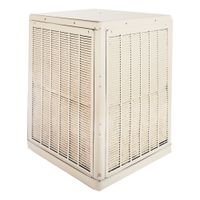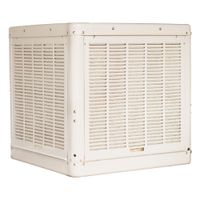Call +(254) 703 030 000 / 751 483 999 / 721 704 777
- Home
- Hvac And Refrigeration
- Air Conditioners Evaporative Coolers
- Evaporative Coolers
- Central Ducted Evaporative Coolers
.....Read More
Frequently Asked Questions
1. How do central ducted evaporative coolers work?
Central ducted evaporative coolers work by utilizing the natural process of evaporation to cool air. These systems consist of a central unit, typically installed on the roof or outside the building, which houses a fan, water pump, and evaporative cooling pads. Here's how they function:
1. **Water Distribution**: The water pump circulates water from a reservoir onto the cooling pads, ensuring they remain saturated.
2. **Air Intake**: The fan draws warm, dry outside air into the unit through the wet cooling pads.
3. **Evaporation Process**: As the warm air passes through the cooling pads, the water on the pads evaporates. This phase change from liquid to vapor absorbs heat from the air, effectively lowering its temperature.
4. **Cooled Air Distribution**: The now-cooled air is pushed by the fan into a network of ducts that distribute it throughout the building. The ducts are strategically placed to ensure even cooling across different rooms.
5. **Ventilation**: Evaporative coolers require open windows or vents to allow the warm indoor air to escape, maintaining a continuous flow of fresh, cool air.
6. **Humidity Control**: While cooling, the system also increases indoor humidity, which can be beneficial in dry climates but may require additional ventilation in more humid areas to prevent excess moisture buildup.
Central ducted evaporative coolers are energy-efficient and environmentally friendly, as they use less electricity compared to traditional air conditioning systems and do not rely on refrigerants. They are most effective in hot, dry climates where the air has low humidity, allowing for maximum evaporation and cooling efficiency.
2. What are the benefits of using a central ducted evaporative cooler?
A central ducted evaporative cooler offers several benefits:
1. **Energy Efficiency**: It consumes significantly less electricity compared to traditional air conditioning systems, as it primarily uses a fan and water pump, leading to lower energy bills.
2. **Eco-Friendly**: By using water as a cooling medium, it reduces reliance on refrigerants that can harm the environment, making it a more sustainable option.
3. **Cost-Effective Installation and Maintenance**: The installation costs are generally lower than those of central air conditioning systems. Maintenance is also simpler and less expensive, involving basic tasks like cleaning and replacing pads.
4. **Improved Air Quality**: It continuously circulates fresh air from outside, reducing indoor pollutants and odors. The process of evaporation also adds moisture to the air, which can be beneficial in dry climates.
5. **Consistent Cooling**: A central ducted system can cool an entire home or building evenly, providing consistent temperatures throughout all rooms.
6. **Quiet Operation**: These systems typically operate more quietly than traditional air conditioners, enhancing comfort without the disturbance of loud noise.
7. **Humidity Control**: In arid regions, the added humidity can improve comfort levels and prevent issues like dry skin and static electricity.
8. **Natural Cooling Process**: It uses the natural process of evaporation, which can be more comfortable for some people compared to the dry, cold air produced by conventional air conditioners.
9. **Scalability**: The system can be scaled to fit different sizes of homes or buildings, making it versatile for various applications.
10. **Reduced Carbon Footprint**: Lower energy consumption and the absence of harmful refrigerants contribute to a reduced carbon footprint, aligning with green building practices.
3. How much does it cost to install a central ducted evaporative cooler?
The cost to install a central ducted evaporative cooler can vary widely based on several factors, including the brand and model of the cooler, the size of the unit, the complexity of the installation, and regional labor costs. On average, the total cost can range from $2,500 to $6,000.
1. **Unit Cost**: The price of the evaporative cooler itself typically ranges from $1,000 to $3,000. Higher-end models with advanced features or larger capacities will be on the higher end of this range.
2. **Installation Costs**: Professional installation can add $1,500 to $3,000 to the total cost. This includes labor, ductwork, and any necessary modifications to your home. The complexity of the installation, such as the need for additional ductwork or electrical upgrades, can increase costs.
3. **Ductwork**: If your home does not already have ductwork, or if the existing ductwork needs significant modification, this can add to the cost. Installing new ductwork can range from $500 to $2,000, depending on the size and layout of your home.
4. **Additional Costs**: Other potential costs include permits, which can range from $50 to $200, and any additional electrical work, which might add another $100 to $500.
5. **Geographical Variations**: Prices can vary based on location due to differences in labor costs and availability of units.
6. **Seasonal Discounts**: Prices may be lower during off-peak seasons, so timing your purchase and installation can also affect the overall cost.
In summary, while the average cost to install a central ducted evaporative cooler is between $2,500 and $6,000, the final price will depend on the specific circumstances of your home and location.
4. What maintenance is required for central ducted evaporative coolers?
1. **Regular Cleaning**: Clean the cooler's filter pads, water distribution system, and reservoir to prevent mineral buildup and ensure efficient operation. This should be done at least once a season.
2. **Inspect and Replace Pads**: Check the condition of the cooling pads regularly. Replace them if they are worn out or clogged, as this can affect cooling efficiency.
3. **Check Water Levels**: Ensure the water reservoir is filled to the appropriate level. Inspect the float valve for proper operation to maintain correct water levels.
4. **Water Pump Maintenance**: Inspect the water pump for any signs of wear or damage. Ensure it is functioning correctly to distribute water evenly over the pads.
5. **Inspect the Motor and Fan**: Check the motor and fan for any unusual noises or vibrations. Lubricate bearings if necessary and ensure the fan is balanced and free of debris.
6. **Check the Belt**: If the cooler uses a belt-driven fan, inspect the belt for wear and tension. Replace or adjust as needed to prevent slippage and ensure efficient operation.
7. **Inspect Electrical Components**: Check all electrical connections and components for signs of wear or corrosion. Ensure all wiring is secure and in good condition.
8. **Winterization**: Before winter, drain the water from the system to prevent freezing. Clean and cover the unit to protect it from the elements.
9. **Check for Leaks**: Regularly inspect the system for any water leaks, which can lead to water wastage and reduced efficiency.
10. **Professional Servicing**: Schedule annual professional maintenance to ensure all components are in optimal condition and to address any potential issues before they become major problems.
5. Can central ducted evaporative coolers be used in humid climates?
Central ducted evaporative coolers are generally less effective in humid climates. These coolers work by evaporating water to cool the air, which is then distributed throughout a building via a duct system. In dry climates, this process is efficient because the air can absorb more moisture, leading to a significant drop in temperature. However, in humid climates, the air is already saturated with moisture, reducing the evaporation rate and, consequently, the cooling effect.
In humid conditions, the air's capacity to absorb additional moisture is limited, which means the cooling potential of evaporative coolers is significantly diminished. Instead of providing a refreshing cool breeze, the system may circulate air that feels damp and uncomfortable. Additionally, the increased humidity can exacerbate issues like mold growth and indoor air quality problems.
While some advanced evaporative coolers are designed to work in a range of climates by incorporating features like pre-cooling or hybrid systems that combine evaporative and refrigerative cooling, their effectiveness in high humidity is still limited compared to traditional air conditioning systems. These systems use refrigerants to remove heat and moisture from the air, making them more suitable for humid environments.
In summary, while central ducted evaporative coolers can technically be used in humid climates, their performance is suboptimal. For effective cooling in such conditions, alternative systems like traditional air conditioners or hybrid models that incorporate both evaporative and refrigerative cooling are recommended.
6. How do I choose the right size central ducted evaporative cooler for my building?
To choose the right size central ducted evaporative cooler for your building, consider the following factors:
1. **Building Size**: Calculate the total volume of the space to be cooled (length x width x height). This will help determine the airflow needed, measured in cubic feet per minute (CFM).
2. **Climate**: Evaporative coolers are most effective in hot, dry climates. Consider the local climate conditions to ensure the cooler will perform efficiently.
3. **Air Changes per Hour (ACH)**: Determine the number of air changes needed per hour. Typically, 20-30 ACH is recommended for residential spaces, while commercial spaces may require more.
4. **CFM Calculation**: Use the formula: CFM = (Volume of space in cubic feet x ACH) / 60. This will give you the required CFM for your cooler.
5. **Cooler Capacity**: Match the calculated CFM with the cooler's capacity. Ensure the cooler can handle the required airflow for your building size.
6. **Ductwork**: Ensure the existing or planned ductwork can accommodate the airflow without significant pressure loss. Properly sized ducts are crucial for efficient cooling.
7. **Installation Location**: Consider where the cooler will be installed. It should be placed where it can draw in fresh air and distribute it evenly throughout the building.
8. **Energy Efficiency**: Look for models with high energy efficiency ratings to reduce operating costs.
9. **Budget**: Balance the initial cost with long-term savings from energy efficiency and maintenance.
10. **Professional Consultation**: Consult with HVAC professionals to ensure accurate sizing and installation, taking into account all specific building requirements and constraints.
7. What is the difference between central ducted evaporative coolers and traditional air conditioning systems?
Central ducted evaporative coolers and traditional air conditioning systems differ primarily in their cooling mechanisms, energy efficiency, and environmental impact.
Central ducted evaporative coolers work by drawing warm outside air through water-saturated pads, causing the water to evaporate and cool the air. This cooled air is then distributed throughout the building via a duct system. This method is highly energy-efficient, as it relies on the natural process of evaporation and uses less electricity compared to traditional air conditioning. However, its effectiveness is contingent on the ambient humidity levels; it works best in dry climates, as high humidity can reduce its cooling efficiency.
In contrast, traditional air conditioning systems use a refrigeration cycle to cool the air. They draw in warm air from the interior, pass it over a set of coils containing a refrigerant, and then expel the heat outside. This process is effective in a wide range of climates, including humid environments, as it actively removes moisture from the air, providing both cooling and dehumidification. However, traditional air conditioners typically consume more electricity, leading to higher operational costs and a larger carbon footprint.
Additionally, evaporative coolers introduce fresh air into the building, improving indoor air quality, while traditional air conditioners recirculate the same air, which may require additional ventilation systems to maintain air quality. Evaporative coolers are generally less expensive to install and maintain, but they may require more frequent maintenance to prevent mold and mineral buildup.
In summary, the choice between the two systems depends on the specific climate, energy efficiency preferences, and budget considerations.

